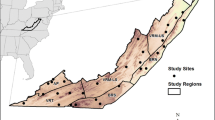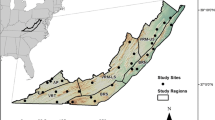Abstract
Herbivory can lead to shifts in ecosystem state or changes in ecosystem functioning, and recovery from herbivory is particularly slow in disturbance-sensitive ecosystems such as arctic tundra. Herbivore impacts on ecosystems are variable in space and time due to population fluctuations and selective utilization of habitats; thus there is a need to accurately predict herbivore impacts at the landscape scale. The habitat utilization and extent of disturbance caused by increasing populations of pink-footed geese (Anser brachyrhynchus) foraging in the high arctic tundra of Svalbard were assessed using a predictive model of the population’s habitat use. Pink-footed geese arrive in Svalbard in early spring when they forage for belowground plant parts; this foraging (called grubbing) can cause vegetation loss and soil disturbance. Surveys of the extent and intensity of grubbing were carried out to develop predictive models that were subsequently tested against data collected during the following year from different areas. Both habitat type at a particular point and the amount of preferred fen habitat in the surrounding area were powerful predictors of grubbing likelihood and the developed model correctly classified over 69% of validation observations with an AUC of 0.75. Pink-footed geese showed a strong preference for wetter habitats within low-lying landscapes. Extrapolation of the predictive model across the archipelago showed that a maximum potential area of 2300 km2 (3.8% of the archipelago) could be disturbed by grubbing. Thus, increasing populations of geese may cause large-scale vegetation loss and soil disturbance in arctic ecosystems.




Similar content being viewed by others
References
Augustin NH, Mugglestone MA, Buckland ST. 1996. An autologistic model for the spatial distribution of wildlife. Journal of Applied Ecology 33:339–347.
Boyce MS. 2006. Scale for resource selection functions. Diversity and Distributions 12:269–276.
Boyce MS, Mao JS, Merrill EH, Fortin D, Turner MG, Fryxell J, Turchin P. 2003. Scale and heterogeneity in habitat selection by elk in Yellowstone National Park. Ecoscience 10:421–431.
Bråthen KA, Ims RA, Yoccoz NG, Fauchald P, Tveraa T, Hausner VH. 2007. Induced shift in ecosystem productivity? Extensive scale effects of abundant large herbivores. Ecosystems 10:773–789.
Côté SD, Rooney TP, Tremblay JP, Dussault C, Waller DM. 2004. Ecological impacts of deer overabundance. Annual Review of Ecology Evolution and Systematics 35:113–147.
Epstein HE, Beringer J, Gould WA, Lloyd AH, Thompson CD, Chapin FS, Michaelson GJ, Ping CL, Rupp TS, Walker DA. 2004. The nature of spatial transitions in the Arctic. Journal of Biogeography 31:1917–1933.
ESRI. 2004. ArcGIS, Environmental Systems Research Institute, Inc., Redlands, CA, USA.
Forbes BC, Ebersole JJ, Strandberg B. 2001. Anthropogenic disturbance and patch dynamics in circumpolar Arctic ecosystems. Conservation Biology 15:954–969.
Fox AD, Bergersen L. 2005. Lack of competition between barnacle geese Branta leucopsis and pink-footed geese Anser brachyrhynchus during the pre-breeding period in Svalbard. Journal of Avian Biology 36:173–178.
Fox AD, Madsen J, Boyd H, Kuijken E, Norriss DW, Tombre IM, Stroud DA. 2005. Effects of agricultural change on abundance, fitness components and distribution of two arctic-nesting goose populations. Global Change Biology 11:881–893.
Fox TA, Francis IS, Bergersen E. 2006. Diet and habitat use of Svalbard pink-footed geese Anser brachyrhynchus during arrival and pre-breeding periods in Adventdalen. Ardea 94:691–699.
Freeman E. 2007. PresenceAbsence: an R package for presence–absence model evaluation. Rocky Mountain Research Station, Ogden: USDA Forest Service
Gauthier G, Bety J, Giroux JF, Rochefort L. 2004. Trophic interactions in a high Arctic snow goose colony. Integrative and Comparative Biology 44:119–129.
Glahder CM, Fox TA, Hubner CE, Madsen J, Tombre IM. 2006. Pre-nesting site use of satellite transmitter tagged Svalbard pink-footed geese Anser brachyrhynchus. Ardea 94:679–690.
Hansen BB, Henriksen S, Aanes R, Saether BE. 2007. Ungulate impact on vegetation in a two-level trophic system. Polar Biology 30:549–558.
Jefferies RL, Rockwell RF, Abraham KE. 2004. Agricultural food subsidies, migratory connectivity and large-scale disturbance in arctic coastal systems: A case study. Integrative and Comparative Biology 44:130–139.
Jefferies RL, Jano AP, Abraham KF. 2006. A biotic agent promotes large-scale catastrophic change in the coastal marshes of Hudson Bay. Journal of Ecology 94:234–242.
Jensen RA, Madsen J, O’Connell M, Wisz MS, Tommervik H, Mehlum F. 2008. Prediction of the distribution of Arctic-nesting pink-footed geese under a warmer climate scenario. Global Change Biology 14:1–10.
Jones CG, Lawton JH, Shachak M. 1994. Organisms as ecosystem engineers. Oikos 69:373–386.
Lecomte N, Careau V, Gauthier G, Giroux J. 2008. Predator behavior and predation risk in the heterogeneous Arctic environment. Journal of Animal Ecology 77:439–47.
Madsen J, Tamstorf MP, Klaasen M, Eide N, Glahder C, Rigét F, Nyegaard H, Cottaar F. 2007. Effects of snow cover on the timing and success of reproduction in high-Arctic pink-footed geese Anser brachyrhynchus. Polar Biology 30:1363–1372.
Manly BFJ, McDonald LL, Thomas DL, McDonald TL, Erickson WP. 2002. Resource selection by animals, 2nd edn. Klewer Academic Publishers, Dordrecht, The Netherlands.
Myers W, Shelton R. 1998. Survey methods for ecosystem management. Wiley-Interscience, New York. 403 p.
Oksanen L, Fretwell SD, Arruda J, Niemela P. 1981. Exploitation ecosystems in gradients of primary productivity. American Naturalist 118:240–261.
Oksanen T. 1990. Exploitation ecosystems in heterogeneous habitat complexes. Evolutionary Ecology 4:220–234.
Ostendorf B, Reynolds JF. 1998. A model of Arctic tundra vegetation derived from topographic gradients. Landscape Ecology 13:187–201.
Palmer SCF, Hester AJ, Elston DA, Gordon IJ, Hartley SE. 2003. The perils of having tasty neighbors: Grazing impacts of large herbivores at vegetation boundaries. Ecology 84:2877–2890.
Pearce J, Ferrier S. 2000. Evaluating the predictive performance of habitat models developed using logistic regression. Ecological Modelling 133:225–245.
Pezzanite B, Rockwell RF, Davies JC, Loonen MJJE, Seguin RJ. 2005. Has habitat degradation affected foraging behavior and reproductive success of lesser snow geese (Chen caerulescens caerulescens)? Ecoscience 12:439–446.
Power ME, Tilman D, Estes JA, Menge BA, Bond WJ, Mills SL, Daily G, Castilla JC, Lubchenco J, Paine RT. 1996. Challenges in the quest for keystones. Bioscience 46:609–20.
R Core Development Team. 2008. R: A language and environment for statistical computing, R Foundation for Statistical Computing, Vienna, Austria.
Rønning OI. 1996. The flora of Svalbard, Translation Third edn. Norwegian Polar Institute, Oslo, Norway.
Root RB. 1973. Organization of a plant-arthropod association in simple and diverse habitats - fauna of collards (Brassica-Oleracea). Ecological Monographs 43:95–120.
Seagle SW, McNaughton SJ. 1992. Spatial variation in forage nutrient concentrations and the distribution of Serengeti grazing ungulates. Landscape Ecology 7:229–241.
Senft RL, Coughenour MB, Bailey DW, Rittenhouse LR, Sala OE, Swift DM. 1987. Large herbivore foraging and ecological hierarchies. Bioscience 37:789–799.
Sjögersten S, Van der Wal R, Woodin SJ. 2006. Small-scale hydrological variation determines landscape CO2 fluxes in the high Arctic. Biogeochemistry 80:205–216.
Tamstorf MP, Aastrup P, Cuyler LC. 2005. Modelling critical caribou summer ranges in west Greenland. Polar Biology 28:714–724.
Van de Koppel J, Rietkerk M, Weissing FJ. 1997. Catastrophic vegetation shifts and soil degradation in terrestrial grazing systems. Trends in Ecology & Evolution 12:352–356.
Van der Wal R, Sjögersten S, Woodin SJ, Cooper EJ, Jonsdottir IS, Kuijper D, Fox TAD, Huiskes AD. 2007. Spring feeding by pink-footed geese reduces carbon stocks and sink strength in tundra ecosystems. Global Change Biology 13:539–545.
Van der Wal R. 2006. Do herbivores cause habitat degradation or vegetation state transition? Evidence from the tundra. Oikos 114:177–186.
Waldram MS, Bond WJ, Stock WD. 2008. Ecological engineering by a mega-grazer: white rhino impacts on a South African savanna. Ecosystems 11:101–112.
Wilby A, Shachak M, Boeken B. 2001. Integration of ecosystem engineering and trophic effects of herbivores. Oikos 92:436–444.
Wilmshurst JF, Fryxell JM, Farm BP, Sinclair ARE, Henschel CP. 1999. Spatial distribution of Serengeti wildebeest in relation to resources. Canadian Journal of Zoology 77:1223–1232.
Wisz MS, Tamstorf MP, Madsen J, Jespersen M. 2008. Where might the western Svalbard tundra be vulnerable to pink-footed goose (Anser brachyrhynchus) population expansion? Clues from species distribution models. Diversity and Distributions 14:26–37.
Young KL, Woo MK, Edlund SA. 1997. Influence of local topography, soils, and vegetation on microclimate and hydrology at a high Arctic site, Ellesmere Island, Canada. Arctic and Alpine Research 29:270–284.
Zimov SA, Chuprynin VI, Oreshko AP, Chapin FS, Reynolds JF, Chapin MC. 1995. Steppe-tundra transition - a herbivore-driven biome shift at the end of the Pleistocene. American Naturalist 146:765–794.
Zonneveld IS, Lebouille M, de Nies N. 2005. Landscape ecology (‘land unit’) map of Edgeøya, Spitsbergen with emphasis on vegetation. In: Boschman N, Hacquebord L, Eds. Permanence in diversity. Netherlands Ecological Research on Edgeøya, Spitsbergen; Arctic Centre, University of Groningen, Netherlands
Acknowledgments
The authors are grateful to the Sysselmannen of Svalbard for research permission and use of the cabin at Fredheim. Thanks are due to Adam Bratt and Jonathan McAllister for field assistance and the UNIS Logistics Department for support and transportation in the field. The design of this study benefited from inspirational discussions in the field with Jesper Madsen. Valuable comments from Johan Olofsson and one anonymous referee improved this manuscript. This work was made possible through funding from NERC (NER/S/A/2005/13880).
Author information
Authors and Affiliations
Corresponding author
Additional information
J. D. M. Speed was involved in the design of the study, carried out fieldwork and analysis, and wrote the paper with contributions from all other authors; S. J. Woodin conceived the study; H. Tømmervik created the habitat map, M. P. Tamstorf created the snow cover map; R. van der Wal was involved in fieldwork and the conception and design of the study.
Rights and permissions
About this article
Cite this article
Speed, J.D.M., Woodin, S.J., Tømmervik, H. et al. Predicting Habitat Utilization and Extent of Ecosystem Disturbance by an Increasing Herbivore Population. Ecosystems 12, 349–359 (2009). https://doi.org/10.1007/s10021-009-9227-7
Received:
Revised:
Accepted:
Published:
Issue Date:
DOI: https://doi.org/10.1007/s10021-009-9227-7




